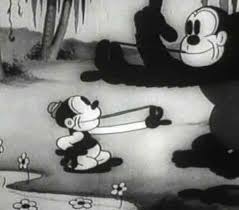
Well its time for another Looney Tunes Re-Watch. This is the second Looney Tune and we have Bosko again but without Honey. The cartoon starts with Bosko walking slowly through the woods, screaming in time to the ominous music. After a few screams, his fears are justified when a large tiger comes up behind him. The tiger goes unnoticed until it decides to lick Bosko's backside. Confronted by the beast, Bosko raises his gun and fires - producing a lot of smoke and a small BB drops out of the end. The chase begins again in earnest and Bosko manages to defy all laws of physics and biology to get away. He then sings to the tiger, and they seem to be getting along - until Bosko kicks the tiger off a cliff.
Bosko then meets a small monkey or gorilla with a tail (not really sure) who spits in his eye because Bosko violates his personal space. Bosko spanks the child primate until "mommy" shows up. The large gorilla is subdued with gum, which they pull out and play as stringed instruments. This of course leads to the entire jungle dancing and playing music.
Notable gags:
Bosko is stretched while running from the tiger, he lifts his rear half up and pulls it toward himself while still moving forward.
Animals apparently have flaps in their fur which allow for underwear/bare bums to be shown
There is an awful lot of reused animation, most notably when the two monkeys are dancing on the log.
Last but not least, a palm tree comes to life, turning the palm fronds into a grass skirt and the coconuts, well lets just say it was a female tree. One of "fer" coconuts comes off while she is twirling(can't think of a better word here - Help!) and hits Bosko in the head.
These early cartoons never concerned themselves much with plot, focusing more on gags than set-ups and punchlines. This is fine, many later cartoons forget the original premise three seconds in. The problem is the gags just don't really work much now. I have to wonder how well they really worked then. Maybe the newness of this form of entertainment was novel enough that an elephant playing his trunk like a trombone was fascinating. Today it falls a little flat.
One thing that does stick out to me though, is the genesis of the "gleeful sadism" that will mark many a later cartoon. Sure, Bosko was attacked by the tiger first, but why did he have to befriend the thing right before kicking it off a cliff to its presumable death? And a smile and not a hint of an afterthought. I am not trying to be preachy here, I am not saying the cartoonists should not have put this in or anything. I am simply musing on this facet of the genre. I guess the fault in this particular cartoon is that the act of violence wasn't particularly clever or funny, so it is easier to pick it apart. I was just watching Tom Turk and Daffy today and Daffy was completely cruel to Tom. But it was funny somehow, and daffy had less (read "None") provocation. This is, however, an aspect of the Warner cartoons I intend to keep track of. Maybe a pattern or explanation will present itself later.
That's all I have for now. No idea when the next installment will be. Proably a couple of days, but maybe tomorrow. Judging by the apparent readership, no one will have read most of these posts until months after they're done.
Hoping I'm wrong about that last,
--Jack


